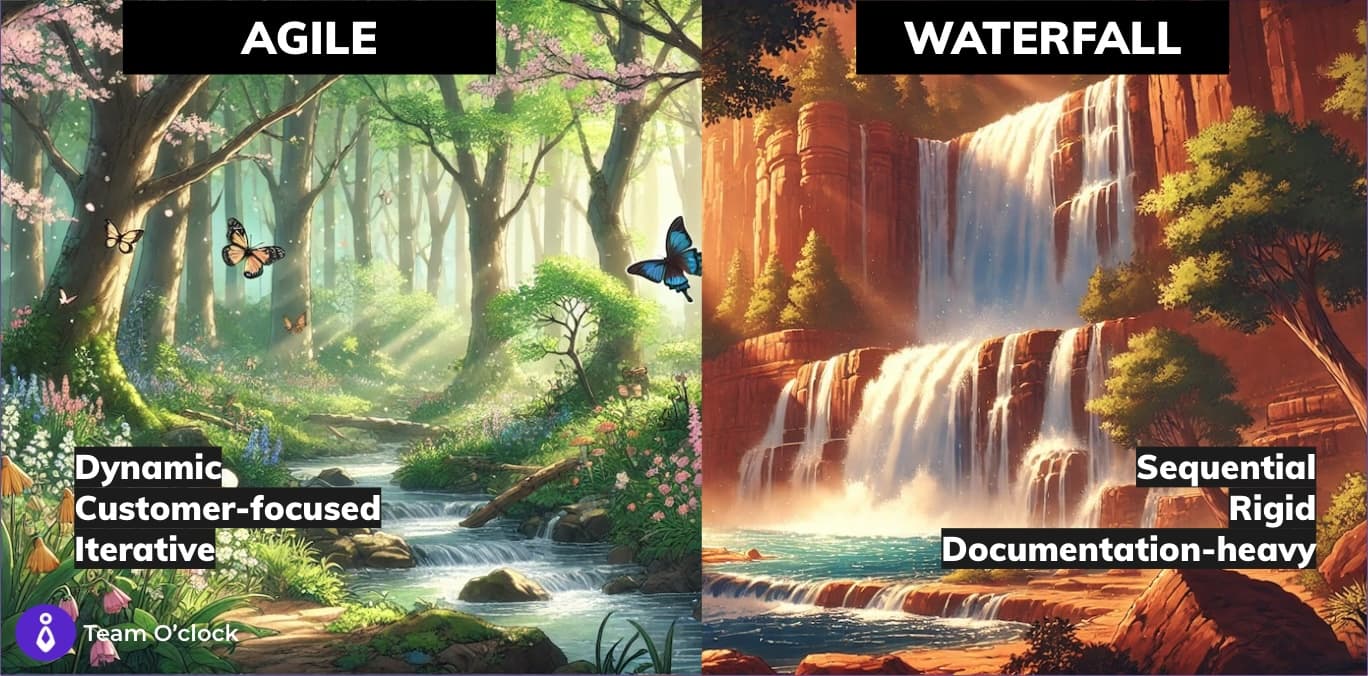
Agile or Masked Waterfall? Are You Sure You're Not Faking It?

Despite adopting Agile terminology, many companies are still trapped in the Waterfall mindset. Are you one of them? Is your Agile practice just a façade for traditional Waterfall methods? Let's find out.
The terms "Agile" and "Waterfall" have become staples in the software development vocabulary, yet they represent fundamentally different methodologies. Agile is iterative, flexible, and customer-centric, while Waterfall is sequential, rigid, and process-heavy.
Despite the widespread adoption of Agile terminology, many companies are still trapped in a Waterfall mindset. Are you one of them? This blog will help you find out by clarifying the two terms. Understanding their differences will allow you to embrace Agile and your business to stay competitive and successful.
Agile vs. Waterfall – Understanding the Basics
What is the Agile Methodology?
Agile is a methodology that emphasizes adaptability, continuous delivery, and customer feedback. It emerged as a response to the inflexibility of traditional Waterfall development. The Agile Manifesto, created in 2001, encapsulates the core values and principles of Agile:
Individuals and interactions over processes and tools
Working software over comprehensive documentation
Customer collaboration over contract negotiation
Responding to change over following a plan
These values underscore the importance of flexibility, direct communication, and delivering functional software.
What is the Waterfall Methodology?
Waterfall, on the other hand, is a linear and sequential approach to software development. It consists of distinct phases: requirements, design, implementation, verification, and maintenance. Each phase must be completed before moving to the next, leading to rigid planning, extensive documentation, and late-stage testing.
Agile VS Waterfall: Key Differences
Agile | Waterfall |
Flexibility: It welcomes change at any stage to facilitate the progress | Rigidity: It resists change once a phase is completed. |
Customer Collaboration: It prioritizes ongoing customer interaction | Contract Negotiation: It relies on upfront contract agreements |
Working Software: It focuses on delivering functional products early and often | Comprehensive Documentation: It emphasizes detailed documentation |
Agile: A Solution to Traditional Development Woes
The evolution from Waterfall to Agile was driven by the need to address the shortcomings of traditional development methods. Waterfall’s rigidity often led to delays, inflexibility, and products not meeting customer needs.
The Agile Manifesto was born out of necessity, aiming to create a more flexible and responsive development process. It introduced four key values and twelve principles to guide Agile practices. These principles include welcoming changing requirements, delivering working software frequently, and promoting sustainable development through continuous attention to technical excellence.
The Masked Waterfall Phenomenon
What Are the Masked Waterfall Practices?
Despite shifting towards Agile, many organizations practice Waterfall in disguise. These "masked" Waterfall practices use Agile terminology without truly embracing its principles.
Common masked patterns include:
Sprints Without Adaptability | Lack of Continuous Integration | Insufficient User Involvement | Overemphasis on Documentation | Siloed Teams |
Fixed scope sprints mimicking Waterfall's rigid phases.
| Delayed integration resembling Waterfall’s end-phase testing. | Minimal customer feedback, akin to Waterfall’s late-stage reviews.
| Excessive focus on documents over working software.
| Isolated teams prevent cross-functional collaboration. |
What Is The Impact of Masked Waterfall Patterns?
Sprints Without Adaptability | Lack of Continuous Integration | Insufficient User Involvement | Overemphasis on Documentation | Siloed Teams |
Teams treating sprints as mini Waterfalls avoid revisiting the backlog or adapting to change. This practice undermines the Agile principle of flexibility and responsiveness to evolving requirements. | Deferring integration tasks until the end of the sprint or project causes bottlenecks and integration issues. Continuous integration is essential in Agile to detect and fix problems early. | Rare customer reviews lead to products that do not align with user needs. Agile requires regular customer feedback to ensure the product meets expectations.
| Prioritizing comprehensive documents over functional deliverables contradicts Agile's focus on delivering working software. Documentation should support development, not overshadow it.
| Working in isolation prevents effective communication and collaboration among teams. Agile promotes cross-functional teams to enhance cooperation and efficiency. |
Embracing True Agile: How to Do it Right in 3 Steps
1. Cultivate an Agile Mindset
To truly embrace Agile, organizations must deeply adopt its values and principles and foster a culture that values adaptability, collaboration, and continuous improvement.
2. Implement Effective Agile Practices
Adaptive sprints: Regularly revisit and adjust the sprint backlog based on feedback and changing requirements.
Continuous integration: Integrate code frequently to identify and resolve issues early, ensuring a stable and functional product.
User involvement: Engage customers regularly for feedback and validation throughout the project lifecycle.
Balanced documentation: Focus on essential documentation that aids development without hindering progress.
Cross-functional teams: Encourage collaboration across different functional areas to break down silos and promote teamwork.
3. Measure and Improve
Review and reflect on practices regularly through retrospectives. Use metrics and feedback to drive continuous improvement, ensuring that Agile principles are upheld and practiced effectively.
Takeaway
In summary, distinguishing between true Agile and masked Waterfall practices is crucial for organizations aiming for genuine Agile transformation. You can achieve more innovative, responsive, and successful project outcomes by evaluating your practices, identifying and eliminating masked patterns, and committing to authentic Agile adoption. Embracing true Agile can lead to a culture of continuous improvement and customer satisfaction, positioning your organization for long-term success.
Agile is more than a set of practices; it is a mindset. Commit to true Agile transformation and reap the rewards of a more adaptable, efficient, and collaborative approach to software development. Sign up today and test our agile solutions with a free 15-day trial!

More articles to check

Assist your team's growth with our partnership program:








